April 2010 archive
Apr 03 2010
Docudharma Times Saturday April 3
Apr 03 2010
Random Japan

GO FIGURE
Estimating the cost of competing at the elite level at ¥20 million a year, two-time Olympic figure skater Fumie Suguri made a public plea for sponsorship funding.In other news from the ice, the future of Japanese figure skating looks to be secure after Yuzuru Hanyu and Kanako Murakami won the men’s and women’s world junior titles.
Disgraced sumo wrestler Asashoryu held a press conference in his native Mongolia, telling reporters he “didn’t commit any violent acts” after all, despite retiring last month after being accused of beating up a man outside a bar in a drunken rage.
Urawa Reds soccer team officials launched “Project Eagle,” unleashing a few birds of prey to chase pesky ducks away from their training field. The ducks, it seems, were leaving plenty of droppings and feathers on the pitch.
Teenage golf phenom Ryo Ishikawa skipped a US PGA Tour event so that he could attend his high school graduation ceremony.
A new museum is opening this summer at Yahoo Dome in Fukuoka to honor the life and times of baseball legend Sadaharu Oh, who still holds the all-time home run record of 868 (no asterisk required).
A gold medal from the first modern Olympic Games held in Athens in 1896 was stolen from a Tokyo museum.
Apr 03 2010
Who is a Terrorist?
Who is a terrorist? That is the question that has sparked what may well be the biggest fight for America in decades.
WASHINGTON – Senior lawyers in the Obama administration are deeply divided over some of the counterterrorism powers they inherited from former President George W. Bush, according to interviews and a review of legal briefs.
The rift has been most pronounced between top lawyers in the State Department and the Pentagon, though it has also involved conflicts among career Justice Department lawyers and political appointees throughout the national security agencies.
The very next paragraph shows us why this battle could very well save, or destroy, the America our founding fathers envisioned.
The discussions, which shaped classified court briefs filed this month, have centered on how broadly to define the types of terrorism suspects who may be detained without trials as wartime prisoners. The outcome of the yearlong debate could reverberate through national security policies, ranging from the number of people the United States ultimately detains to decisions about who may be lawfully selected for killing using drones.
The TYPES of terrorism suspects that may be detained without trials as wartime prisoners is the core of this fight.
Apr 03 2010
Original v. Cover — #19 in a Series
This week’s feature song was first released as a single in 1971 when it reached #1 on the Billboard Hot 100, remaining on the charts for 16 weeks, rose to #1 on the Billboard R&B chart, where it remained for 9 weeks, and topped out at #7 on the charts in the U.K. It was ranked at #60 on Rolling Stone magazine’s list of 500 Greatest Songs of All Time.
Apr 03 2010
FRIDAY NIGHT DISTRACTIONS
Well it`s good Friday again, or Good Friday.
Still & all, we all try to look to the better things, through hopes, dreams, & aspirations.
Tonight I have images that show progression.
Others that show inevitability, such as a sunset.
And yet others that evoke hope for the future of the subject in the image, be it singular, or as a species.
These images are not in any way as serious as the intro may suggest.
To prove it, here`s a pod.
FUZZ TO BUZZ
Apr 03 2010
New mortgage trap increases taxpayer risk, if it works!
Feeling distressed about mortgage payments? The government would like to help. Just press the little red button.
Apr 03 2010
Friday: On Meta
300 Spring Equinoxes Ago
http://www.firstpeople.us/FP-H…
An Assiniboin | Cree | Sioux Legend
The Legend of the White Horse Plain by Margaret Arnett MacLeodManitoba Pageant, January 1958, Volume 3, Number 2
This article was published originally in Manitoba Pageant by the Manitoba Historical Society on the above date. We make it available here as a free, public service in hopes it will continue to be useful. Gateway to the west is a name frequently used to designate the city of Winnipeg, since it stands on the eastern edge of the Canadian prairies.
__________________The city looks west over a small area which was known as the White Horse plain. There, in the lee of a ridge to the west and north, the hamlet of Grantown was founded in 1824. This nucleus of settlement, 18 miles west of present day Winnipeg, was later renamed and is today the village of St. Francois Xavier.
The ridge was early called the Coteau de Festin, since from time immemorial it had been noted as a gathering place for the Indians – a place where they held dog feasts, sun dances and other celebrations.
This beginning of the western prairies is a storied place, the only area around Winnipeg which has left us a legend – the legend of White Horse plain. For more than two and a half centuries this region has been called the White Horse plain. It carried that name for more than 50 years before the first white man set foot in the west, for over a hundred years before Manitoba existed; for so long indeed that the actual occurrence which named it has been almost forgotten by its people, leaving only the legend it engendered.
The legend as given here is the version which was most widely corroborated for me by old residents of White Horse plain and others.
____________________In an early period of the seventeenth century, when only Indians roamed the western plains, the most northerly nation, the Crees, were being pushed farther and farther towards Hudson Bay by their traditional enemies, their fierce neighbors to the south, the Sioux.
Finally the Sioux gained a foothold in the wealthy Cree country as far north as Lake Winnipeg and the point north of the tip of Lake Superior, now known as Sioux Lookout. It was a serious situation for the Cree. They were desperate. In this barren land they faced near starvation and possible extinction. Then came their salvation, the arrival of the white men at Hudson Bay with whom they soon began to trade. Before long they had the white man’s guns and were making effective war with them against the bows and arrows of the Sioux. So the invaders in turn were pushed farther and farther back into their own territory, and the Cree became the great warriors, more invincible than ever the Sioux had been.
As a consequence of this, the Crees’ nearest neighbors to the south, the Assiniboines, a branch of the Sioux who formerly had protected the Sioux from the incursions of the Crees, were glad not only to make peace but later to ally themselves with this powerful and irresistible nation which fought their enemies with fire.
Against this alliance the Sioux, though flaming inwardly, could do nothing. Nevertheless they kept a jealous eye on the movements of both.
Early one summer in the 1690s, a large band of Assiniboines was camped on the banks of the Assiniboine river about ten miles west of the centre of present day Winnipeg. The chief of these Assiniboines had a beautiful daughter, and to his lodge came two suitors for her hand – a Cree chief from Lake Winnipegosis and a Sioux chief from Devil’s Lake.
The Cree was the favored suitor for he had to offer in exchange for a bride that rarity, that coveted prize of the prairies, a horse as white as the winter snows, a Blanco Diablo which came from that famed breed in Mexico. Nimble of foot, swift as the wind, strong and sturdy, a “white devil” could out-run and out-last any other horse, and go three or four days longer than any other without food or water.
The prospect of such a gift was irresistible, and the father succumbed. But not all the Assiniboines in the camp favored the alliance with the Crees, notably a powerful medicine man. The memory of Cree war parties with Assiniboine scalps flying in the wind was ever before his eyes and he nursed in his heart the old bitterness.
“Is it not enough”, he thundered at his chief, “that you should make peace with the enemies of our forefathers? Now you will disgrace us by mingling our blood with that of our foes!” But his protests were in vain. So he sought by his magic and exhortations to strengthen in the camp the hatred against the Crees.
The marriage was planned for a time when the Sioux chief was to be on a war expedition, but they counted without the medicine man. Secretly he sent off word of his rival’s success to the young Sioux.
On the day appointed for the ceremonies, the Cree bridegroom, gorgeous in the trappings of his chief-dom, arrived from Lake Winnipegosis mounted on a fine grey steed, and leading the white horse loaded with additional presents for his prospective father-in-law.
The gifts were presented and the Cree claimed his bride. Then, with the feasting and merrymaking scarce begun, suddenly there was an alarm – a cloud of dust in the distance. The flouted and vengeful suitor with an escort of Sioux warriors was fast approaching over the prairie.
All was confusion in the camp. Cries of Sioux and Cree sympathizers alike filled the air. “Up, up! Away! It is your only chance!” cried the bride’s father to the Cree. “Take your horses and flee!”
The bridegroom ran with his bride to the tethered horses, helped her mount the white steed, jumped to the grey in a flash and they were off. Westward they flew, but not unobserved. The Sioux with his party was quickly in pursuit.
But even the time gained at the start and the swift pace of their fleeing ponies did not save the bridal couple. Though they doubled back on their tracks to mislead their pursuers and at times were hidden by patches of bush, once out on the open plain again the white horse was the mark that betrayed them.
On, they sped over the prairie. The frightened girl held back the pace of her horse to that of her husband’s grey, and the Sioux were gaining on them.
Finally at a point just east of the present day village of St. Francois Xavier,the avenging arrows of the Sioux sped to the hearts of the fleeing couple and killed them both.
The grey horse was wounded, but the white steed escaped into the deep woods. For years it roamed the plain, thus giving its name to the region, and the Indians, believing that the soul of the girl had passed into its body, feared to approach it. As time passed the belief grew that, in ghostly form the white horse continued its wild wanderings.
Today there are old residents in the district who recall the tragic story of the Cree chief and his Assiniboine bride, and relate the legend of the Blanco Diablo, which some believe still haunts the Plain.
Apr 03 2010
Americans are Socialist
And they say we’re a center right country. Ha!
(Reuters) Most Americans believe tax hikes are OK if you’re making more than $250,000, a policy proposed by President Barack Obama, but hands off Medicare and Social Security, a poll released on Monday found.
The Quinnipiac University poll found that 60 percent of Americans among both major political parties think raising income taxes on households making more than $250,000 should be a main tenet of the government’s efforts to tame the deficit. More than 70 percent, including a majority of Republicans, say those making more than $1 million should pay more.
But 80 percent say raising taxes on those making less than that should not be part of the government’s approach. Moreover, most oppose touching Medicare and Social Security – two long-term drivers of the budget deficit over the coming decades. Link
h/t TBH
Apr 03 2010
Friday Philosophy: Trans-Dimensional News
 Every month or so, I like to do a summary of the recent news of interest to the trans-community. Welcome to our world.
Every month or so, I like to do a summary of the recent news of interest to the trans-community. Welcome to our world.
My continuing readers may be interested in hearing that we had some success since last week. Israel Luna has decided to withdraw the offensive trailer for Ticked-off Trannies with Knives.
“After listening to some of the voices in the trans community,” Mr. Luna said, “I’ve decided to remove those references from the trailer.”
Meanwhile, for a better portrayal of transwomen, I hear James Rasin’s Beautiful Darling: The Life and Times of Candy Darling, Andy Warhol Superstar is worthwhile. Here’s a preview by Jillian Weiss, which includes the trailer. Candy apparently dreamed of being Kim Novak. Personally, I dreamed of being Shirley MacLaine.
Apr 02 2010
President Placeholder?
Following up on Michael Gass’ One Term President.
Before…

After…
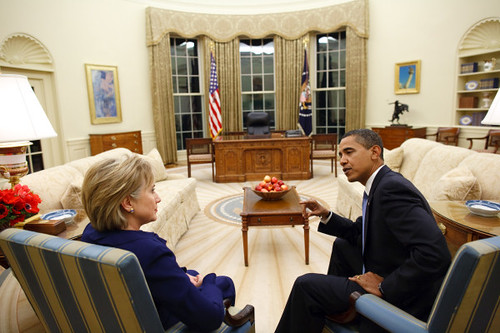
How temporary must a Chief Executive feel when he doesn’t even want to replace the last guy’s office furnishings?
President Obama has not, as yet, changed the Oval Office dramatically. Three subtle changes are the addition of a hand-carved wooden sculpture obtained by him on a 2006 trip to his ancestral home of Kenya. The figurine shows an egg placed gently into a human hand, symbolizing the fragility of power [1]. He has also replaced the Laura Bush-inspired floral decorations with a bowl of wax apples and has replaced the decorative plates on the oval office bookshelves with books. It has been confirmed that some changes will happen to the Oval Office decor; during a meeting with military officials during the first week of the Presidency, Obama surveyed his new environs with a critical eye. “He looked around,” said one of his guests, retired Rear Adm. John D. Hutson, “and said, ‘I’ve got to do something about these plates. I’m not really a plates kind of guy.’“
He also added a bust of MLK.
There may be no better metaphor for Obama’s Presidency so far.
His ‘big’ changes from the Bush era are:
– getting rid of Bush’s tacky plates.
– replacing live flowers with phony fruit.
– adding a bust of the man whose peace loving philosophies he internationally repudiated and another statue that reminds him of his own insecurity.
And that’s all.
A Champion for Change? The guy won’t even order new curtains.
It’s not as if there’s some Presidential decorating convention that says Obama can’t make significant renovations to the Oval Office decor.
Quite the opposite in fact.
Of all the sitting Presidents since the oval office was rebuilt in 1934, only Eisenhower and Carter did NOT change the decor to suit their own personal styles.
Clinton (“Candy Striper”)
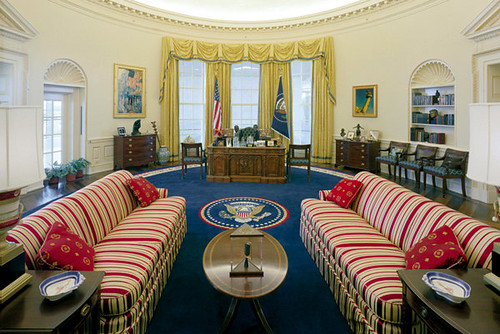
Bush I (“Colonel Kurtz” aka “George of the Jungle”)
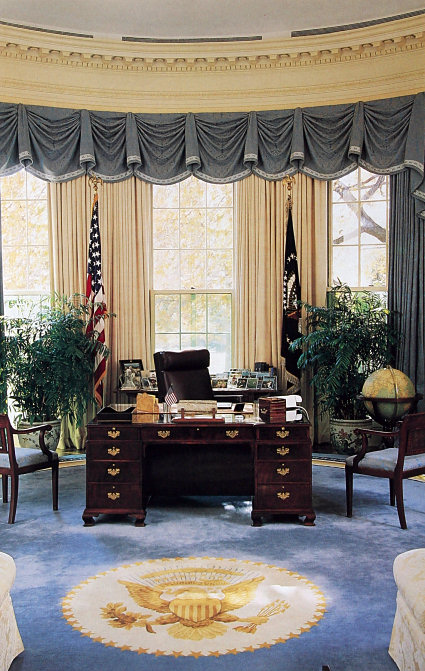
Reagan (“Iran-Cointreau”)

Ford/Carter (“Unpardonable”)
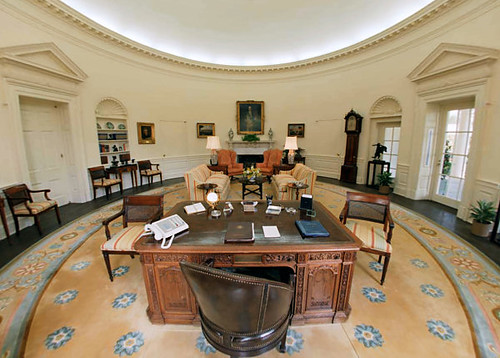
Nixon (“Sound Studio”)

LBJ (“Easy Green”)
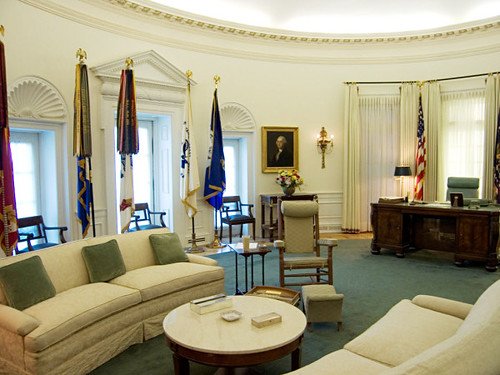
Kennedy (“Red Menace”)
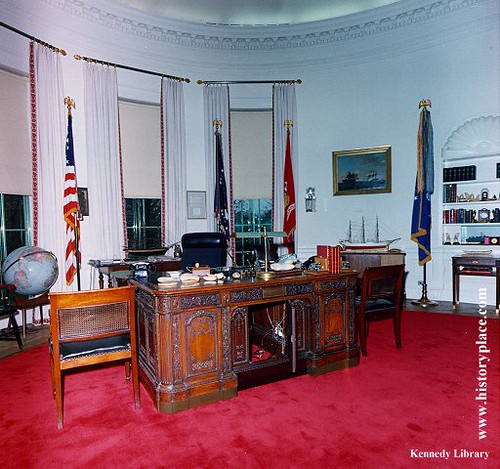
Truman/Ike (“Fallout”)
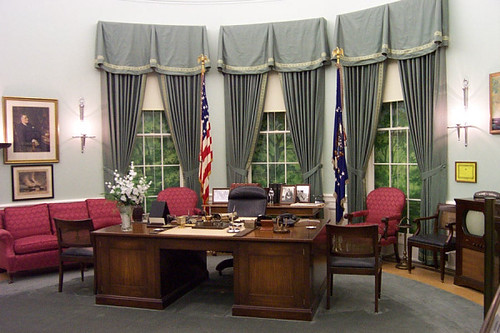
FDR (“The Toy Room”)
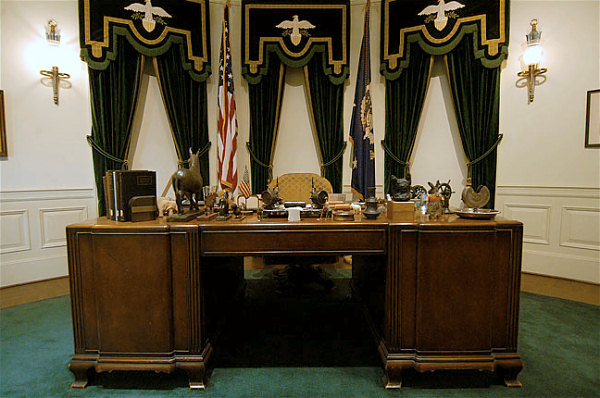
I don’t know if he wants another term or not, but judging from his studied lack of interest in making the Oval Office his own, the President may very well be anticipating NOT taking a second lap.
After all, there’s no great reason for Obama to invest emotional capitol in creating his own personal White House legacy if he already knows he’s one termer.

Far easier simply to borrow Dubya’s for the duration.
Apr 02 2010
The “Poor” Will Always Be With Us
Today is Good Friday and as a result I pause to reflect upon a particularly crucial passage of the story that is as frequently misunderstood as it is frequently quoted. In it, the actions and responses of the principle players still speak to us, even 2,000 years later. The impetus and motivation upon which Judas makes the ignoble decision to betray Jesus lies with this anecdote. I cite it today in an attempt to put the impeding Crucifixion in context. Chronologically the verses fall shortly before Palm Sunday, where Jesus rode triumphantly into Jerusalem to the adoration of thousands of cheering supporters. Jesus has stopped to rest at Lazarus’ house, the man who he had but recently raised from the dead.
Then Mary took about a pint of pure nard, an expensive perfume; she poured it on Jesus’ feet and wiped his feet with her hair. And the house was filled with the fragrance of the perfume. But one of his disciples, Judas Iscariot, who was later to betray him, objected, “Why wasn’t this perfume sold and the money given to the poor? It was worth a year’s wages.”
He did not say this because he cared about the poor but because he was a thief; as keeper of the money bag, he used to help himself to what was put into it. “Leave her alone,” Jesus replied. “[It was intended] that she should save this perfume for the day of my burial. You will always have the poor among you, but you will not always have me.”
Judas was a Zealot, a member of a Jewish political movement devoted to the removal of the occupying Roman Empire by any means necessary. At first, Judas assumed that the Kingdom which Jesus talked about was an earthly one to be established after a violent conflict. However, once he discovered that the Kingdom of Heaven was a spiritual state arrived at neither through violence, nor through material gain, Judas made the decision to betray Him. Judas’ primary devotion was to money and profit, and thus his own selfishness belied his rationalization.
Some have believed over the centuries that Jesus meant that there would always be poverty and that we ought not to worry about it. This is not the case at all. In honesty, I have always felt that Jesus’ response in this situation is directed squarely towards activists, particularly those on the Left. So often we justify our actions and deeds under the guise of piety. It is easy to make a great show out of doing what is best for the less fortunate, especially when our true motives are neither noble nor especially charitable. But there’s also a second dynamic at play too, the idea that our own human desires to help people are subordinate to God’s plan for us. It is as if Jesus is saying “You’ll always have some excuse or some reason to seem socially conscious. After all, the “poor” will always be with you. If it isn’t the “poor” today, it’ll be something else tomorrow.” If it isn’t Darfur today it’ll be Katrina, and if it isn’t Katrina, it’ll be Haiti.
Good intentions quickly become obscured by profit, accumulation, and a desire to win the adulation and approval of others. We fight against the injustice of the world, but often are distracted from the ultimate mission at hand by worldly temptations. Mostly we wish to superimpose our own will and our own itinerary upon the work we do for others, and I imagine God laughs as He brushes that aside. As for me, so long as I follow that voice inside myself that is God and is divinely inspired, I will never go wrong. When I deviate from that guidance and that surety of purpose for whatever reason, then I find myself running into complications and frustrating situations with no resolution. God’s plan for me might be scary at times, but it is never confusing or unclear.
For many people it is difficult to have faith in something that is unfamiliar or cannot be comfortingly explained by reason or readily available information. Humanity is, as we know, inherently mortal and inherently flawed, so missteps and problems are inevitable. Perhaps the best perfection we can achieve is that of complete trust and obedience to a guidance beyond ourselves, one that will not always place us in comfortable spaces, but will certainly always ensure that we are learning and growing. Our resistance is often designed as a means of preventing ourselves from being uncomfortable or braving the unfamiliar, but to be guided by God never promises the easy way out. We can take comfort not that we will always have all the answers, but that we can reach a point where we know that answers will be granted in due time, and in the meantime we will never be given a greater burden than we can handle. In many respects, this is almost Zen-like in its application.
I wish that someday the “poor” might not be with us, as I recognize that there will always be work to do and that inequality and injustice are unlikely to leave us any time soon. May we resolve to help those who need it with a singular purpose of service, setting aside anything else we might wish in the process. That which we need will be provided. We have everything at our disposal that we could possibly ever want, and my prayer is that someday we’ll believe it.




